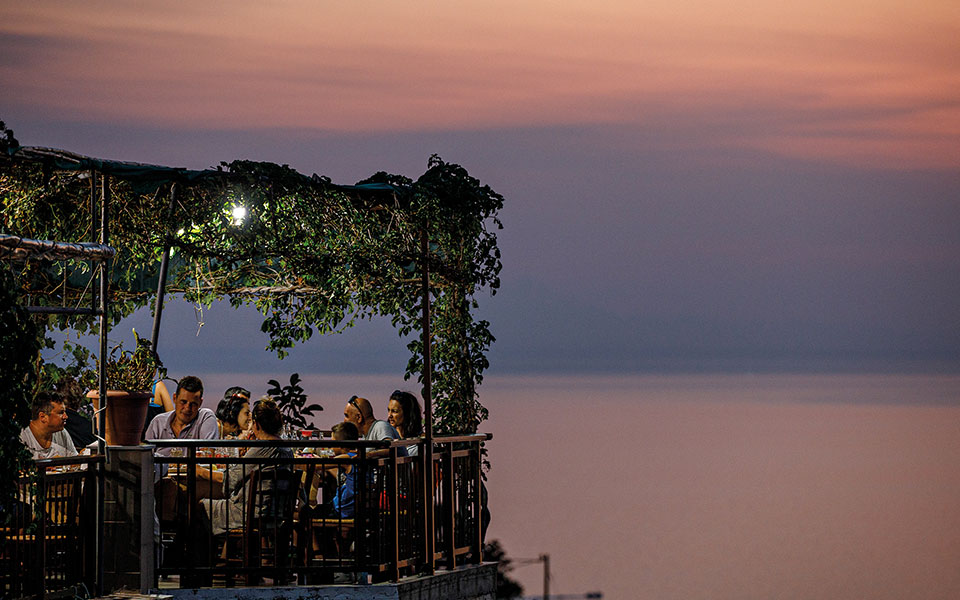On the fringes of the northeast Aegean, between Thasos and Imbros, Samothraki is a place that lives in its own dimension. Here, tourists hitchhike and waiters take orders on notepads. The pebbly beaches are mostly virgin and free, and fish tavernas serve fried garfish instead of tuna tartare.
This nostalgic feeling of old Greece, which praises the joy of simplicity, is undermined by the lack of basic infrastructure: some parts of the road network are dangerous, the important archaeological site of the Sanctuary of the Great Gods has been left to its fate, the Municipal Hydrotherapy Center in Therma with the thermal springs, rich in Sulphur, is inaccessible due to the poor condition of the surrounding area, while on the north-east side free camping is allowed without any terms or conditions. And yet, none of the above is bothersome – the island seems to have invisible filters that act in a cathartic way for its visitors. After all, nature and history are generous with them.
The land of Samothraki, with the sacred soils of the Cabeiri and the unexplored slopes of Mount Saos (whose springs supply the houses with drinking water), sown with all sorts of herbs and remains of prehistoric settlements, is protected by an inexplicable mysterious aura. The island abhors those who rush to discover it, educates and welcomes those who want to really know it. Because, as Yiannis Antoniou, owner of the traditional bakery in Hora told us, “Samothraki is what you can’t see.”
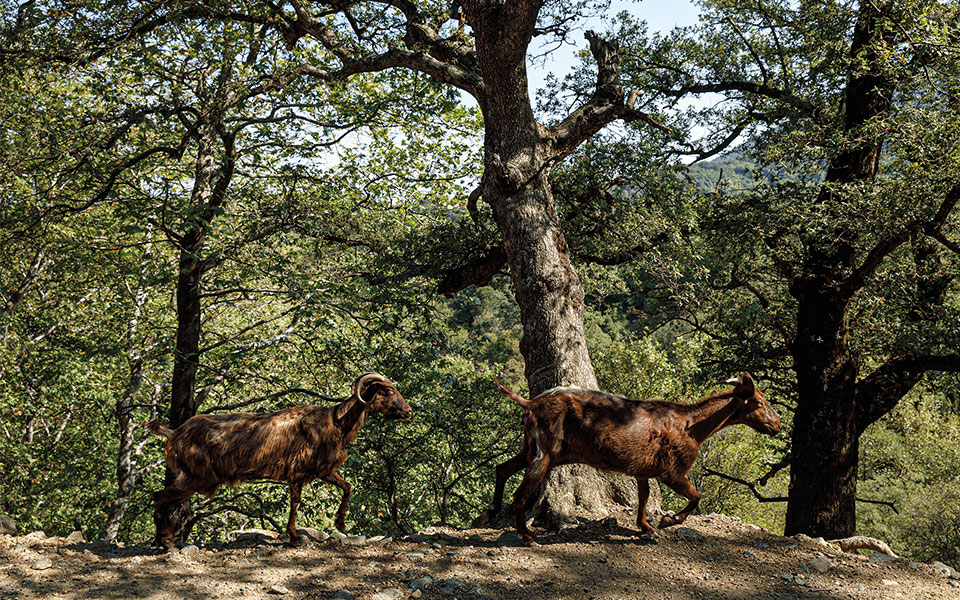
© Konstantinos Tsakalidis
Mount Saos: Ponds, Dense Forests and Adventure
The largest area of the island is occupied by Mount Saos, whose peak, Feggari (meaning moon), exceeds 1,600 meters above sea level. It owes its name to the Proto-Greek word “samos,” meaning “height,” and is the highest mountain in the Aegean, excluding Crete and Evia ̶ it was not by chance that Poseidon chose to watch the Trojan War from up there.
Abundant running waters, windswept valleys, dense forests of plane trees and oaks define the landscape. If you want to touch the soul of Samothraki, you must start from the magical mountain and dive into one of its dozens of ponds.
Our guide was Stamatis Kousvelaris, a certified ICO PRO canyoning instructor, who has been organizing experiential gorge descents and training for the last two years. The first destination is the famous gorge of Fonias, which starts from the location of Karya (700m) and ends at the homonymous cape with the partly destroyed medieval tower. We parked at the end of the gorge and followed an easy path up to a certain point, against the flow of the water, passing between wild olive trees, plane trees, pistacias and terebinths. The landscape is colored in all possible shades of green.
Forty minutes later, we reached the first pond. People were sunbathing on the rocks, admiring the 30m-high waterfall. We continued further up, on a rather difficult route due to the steep slope, whose initial part was secured with a wire rope. Once the path straightened, we walked for ten minutes and shook the heat off us by diving into the second pond.
Info
Hellas Outdoor & Adventure Coaching, Stamatis Kousvelaris, Tel. (+30) 697.266.6428, from June to September daily, prices start at 70 euros for Fonias gorge. Full equipment is provided, except for shoes.
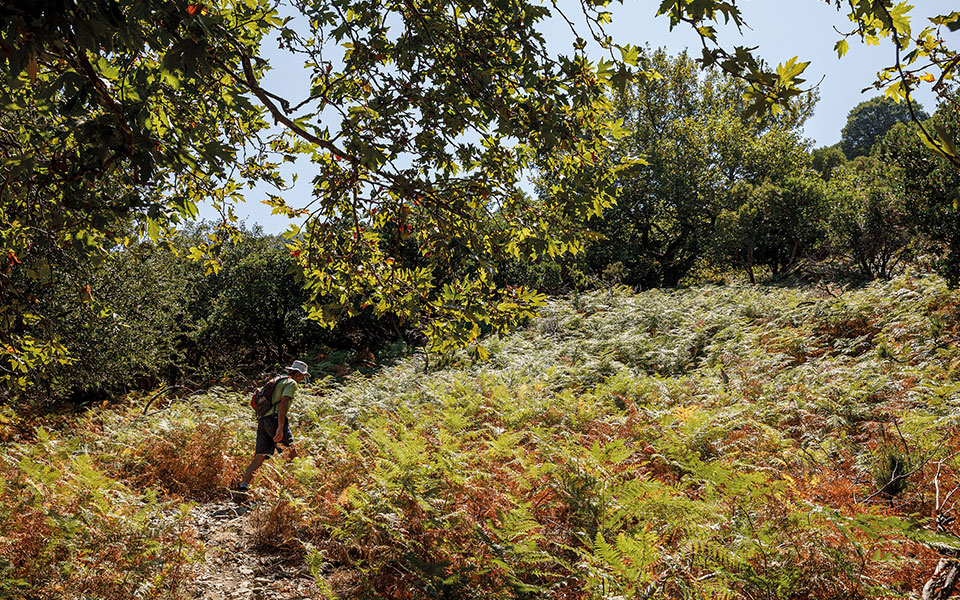
© Konstantinos Tsakalidis
We discovered the most beautiful and adventurous ponds near the Monastery of Christ, in the gorge of Kardelis. The access was easy; it took us a ten minute walk to reach a series of small ponds. We singled out the “balcony,” a difficult to reach rectangular pond, overflowing over the edge of the cliff, thus offering a spectacular view of the sea.
The next day we took the marked path “E6,” outside Therma, to Feggari. Due to lack of time, we did not go all the way up to the top and back, however we approached the forest of Martini with oaks over 100 years old, which is part of the Natura 2000 network. On the way, with our nostrils wide open to the fragrance of oregano and thyme, we crossed a special spot with Greek strawberry trees, which the locals call antrachelies. The shiny red trunks create the impression that the forest is bleeding.
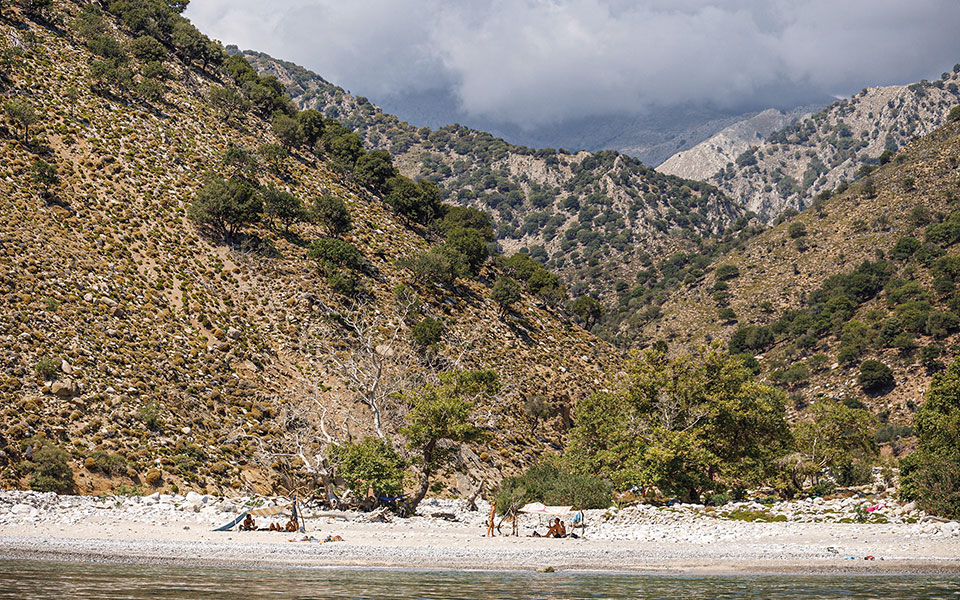
© Konstantinos Tsaklidis
To the South By Sea
The southern part of Samothraki, i.e. the coastline between the beaches of Pahia Ammos and Kipi, is sculpted by the winds and the wildness of the sea. The two beaches can be reached by road but they are not connected by asphalt or by any path. Maybe because they are diametrically opposed.
The first, on the western end, stretches out into a large bay with blue waters and golden sand. Being the only sandy beach on the island, it attracts the most people on the sunbeds of its bars. The setting of the second beach, on the eastern end, consists of dark fine gravel, large pebbles and the deep blue of the sea. Laying on a beach towel here, you will feel like a dot in the universe on the endless shore.
We started from Kipi. As we moved southeast, the landscape changed, olive groves and plane trees giving way to sharp cliffs and wave-washed roads. The Romanian PADI diving instructor, Ioanna Tianou, who last year established here a diving center, was waiting for us in the morning along with her team.
After she explained to us the essentials for scuba diving, we put on the gear and explored the seabed with her. At a depth of five meters we saw various fish, such as gilt-head breams and red mullets, shells and sponges. Afterwards, guided by Andrei, her husband, we boarded an inflatable boat to explore the sea front up to Pahia Ammos.
Info
H20 Dive & Fun Samothraki, Kipi beach, tel. (+40) 732.123.232 & (+30) 698.581.0649, from June to early October, daily 10.00-17.00, from 40 euros per person.
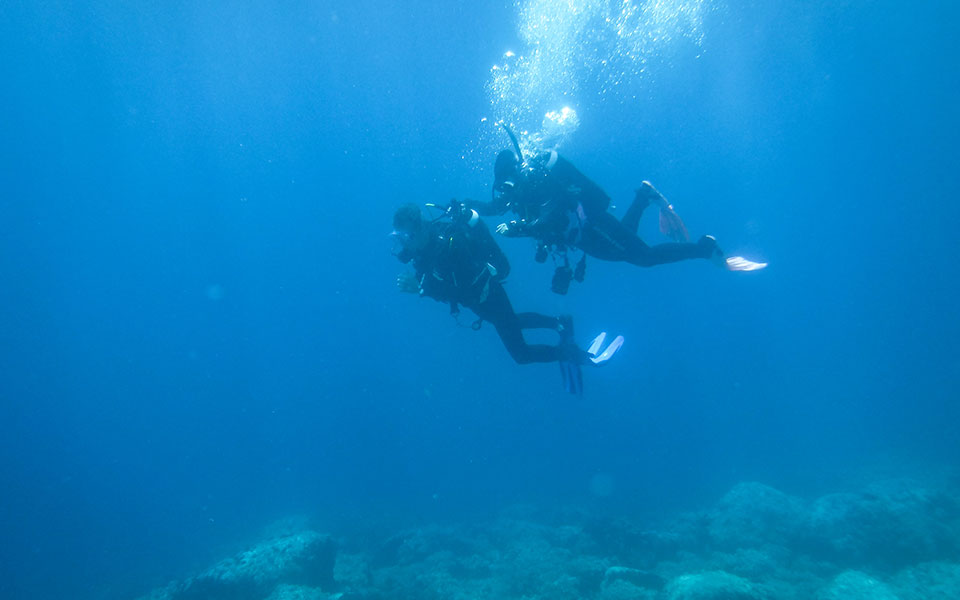
© Konstantinos Tsakalidis
Our eyes couldn’t get enough of the beauty. After the canyon of Gyali we came across Tis Grias Ta Pania (meaning: the old lady’s clothes), a rare geological formation of white stripes spreading over the gray rocks. According to popular tradition, the inhabitants during the Turkish occupation found refuge on the steep slopes. Among them an old woman, whose clothes were scattered by the raging wind. She got angry and cursed them to marble.
Immediately after the natural mural, we heard water crashing into the sea. We were puzzled over this sound until we faced Kremasto Nero (meaning: the hanging water), a 180m-high waterfall, the highest waterfall in Greece.
A little later, after swimming in the blue-green waters of Vatos and its seal caves, we reached Katarti beach. Here, in 1940, a Romanian merchant ship loaded with wood sank. The wreck is visible with a diving mask from the surface of the sea.
After an hour, we disembarked at Pahia Ammos. With the music of the wind and waves in our ears, we had a hard time getting used to the noise of people.
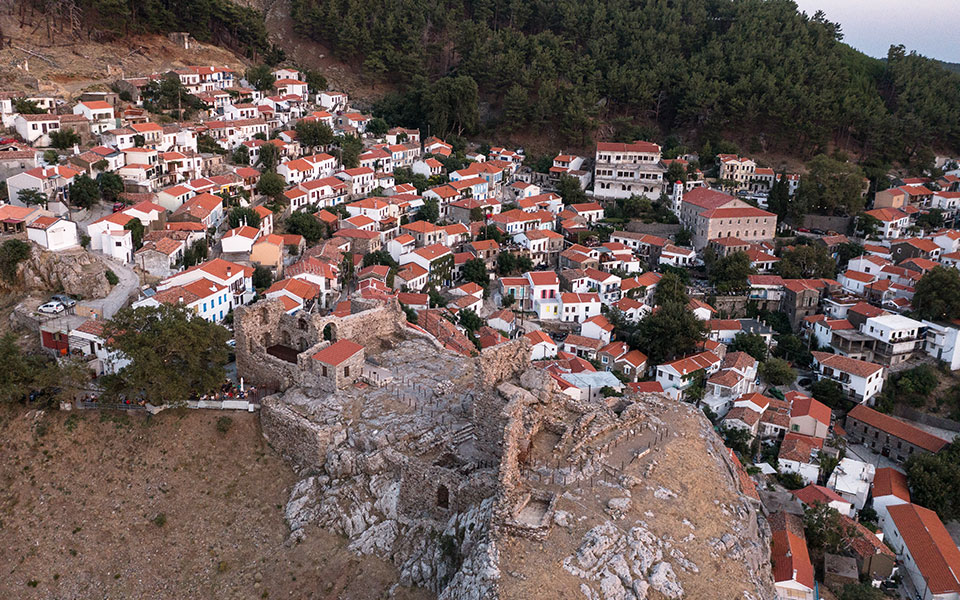
© Konstantinos Tsakalidis
The Hora Called Hourgio
Buried in the rocks, at an altitude of about 300m, embraced by a dense pine forest and invisible from the sea to protect itself from pirate raids, Hora or Hourgio is a beautiful settlement, preserved since 1978. Its two-story white houses, with their tiled roofs, the improvised enclosed balconies and gardens full of geraniums, have been built close together, so that the narrow stone paved streets that connect the neighborhoods are not visible. Among them, a few Aetsa buildings survive, i.e. houses with flat earthen roofs (aetsa), while several are built with the anti-seismic technique of tsatma. Their walls internally consist of a wooden frame covered with a mixture of soil, lime, straw and goat hair, while externally they are covered with planks of wild local oak.
It is recommended that you start your walk in the afternoon so you catch the sunset. Cars must be parked at the entrance of Hora, since it is forbidden to enter it driving. Just above the free parking area, hanging on the rock and founded on the ruins of an ancient Thracian citadel (1100 BC), stands the castle of the Gatilusio family, the Genoese family that ruled the island around 1430. As you climb towards the settlement, you will find large plane trees, pots with hydrangeas and locals chatting from opposite balconies. Dominating is the Church of the Assumption of the Virgin Mary, with its tall bell tower and clock. In the church, which first opened in 1875, you will find the skulls of the five New Martyrs of Samothraki, who were tortured to death by the Turks in 1835.
Info
The House of Maria Ververi from Samothraki, Tel. (+30) 697.303.6229, by appointment. The Traditional Bakery of Samothraki, Tel. (+30) 25510.414.33, from June to September, open from 7:30 in the morning until the products are sold out.
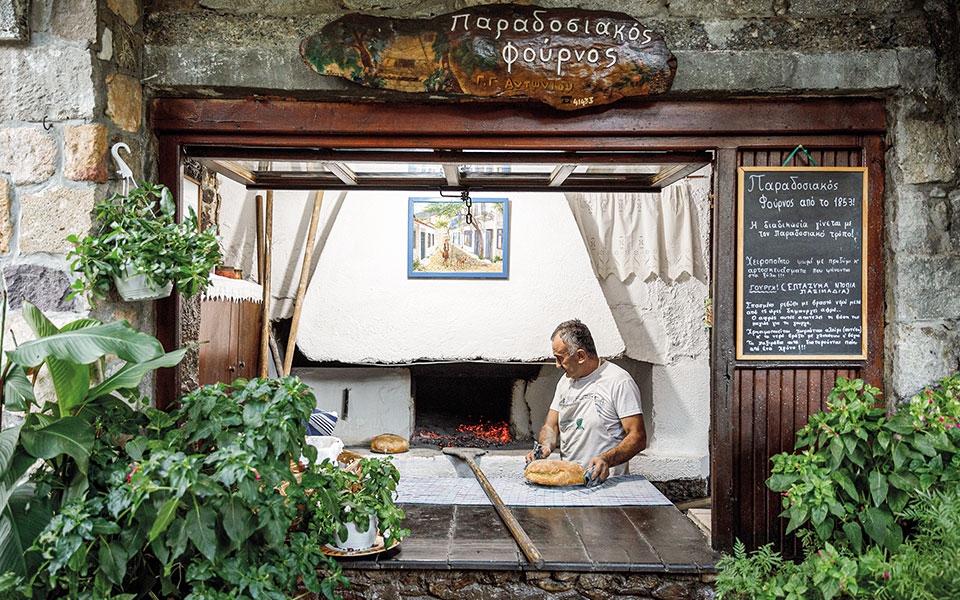
© Konstantinos Tsakalidis
To learn about the history of the place, visit the open museum of the award-winning folklorist and writer Maria Ververi-Krause. Ms Maria, has been sharing the island’s tradition with the visitors, in her father’s yard in the upper neighborhood of Hora, since August 1989. Inside the two-story building, you will find local costumes, kilims, agricultural tools, frames with proverbs and a lot of objects and furniture that reveal the old everyday life of the island’s inhabitants.
Other points of interest are the marble fountain of Kamara with the symbol of the Cabeiri, the two entwined snakes, engraved on it and the traditional bakery of the Antoniou family, which opened in 1853. The two siblings, Eleni and Yiannis, still produce rusks from chickpeas (gourgi), but they keep the bakery, which has been declared as a preserved monument, open only during the summer months. Come early in the morning to try sourdough bread made with village flour (antessa), cheese bread with local goat cheese and delicious peinirli.
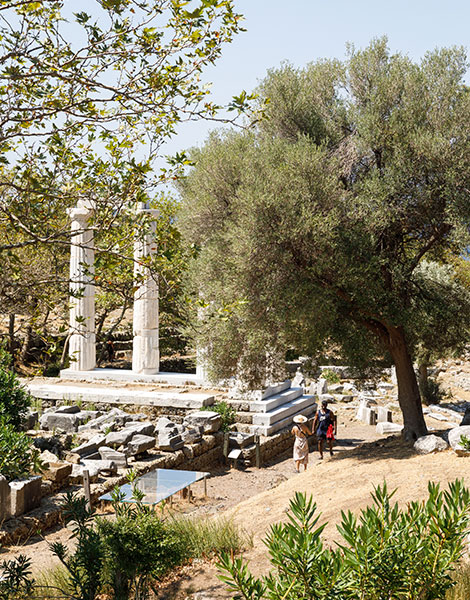
© Konstantinos Tsakalidis
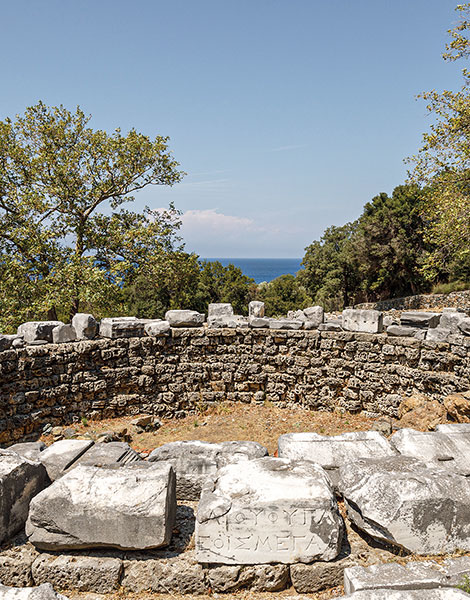
© Konstantinos Tsakalidis
The Sanctuary of the Great Gods
To the northwest, next to Palaeopoli, the ancient city of Samothraki and near the three late-Byzantine towers of the Gatilusio family, is the Archaeological Museum and the Sanctuary of the Great Gods. The first, designed by New York’s Metropolitan Museum of Art architect Stuart Shaw and opened in 1955, is undergoing re-exhibition works. Only room A can be visited, which hosts restored typical parts of important Doric buildings made of Thasos marble, such as the Rotunda of Arsinoe II. Last year, an exact copy of the Winged Victory of Samothrace was placed in the courtyard of the stone museum. The original, exhibited in the Louvre, was initially part of a fountain, when discovered in 1863 by the French vice-consul and illicit dealer in antiquities Charles Chamboiseau.
After 200 meters, having walked down a paved path with olive trees and plane trees and climbed a slippery slope, you will find the iron entrance of the archaeological site. Although our longing to explore the place of the Cabeirian Mysteries turned into a hassle – as there was no warning anywhere that the ticket desk only accepts cash, and were therefore forced to return to Kamariotissa – it was worth it in the end.
The Sanctuary of the Great Gods, an area of about five hectares, is hidden in a ravine at the foot of Mount Saos. It is a landscape of rare natural and historical beauty. Kermes oaks, olive trees, pine trees and oleanders glow under the bright sun and mingle with archaic columns, ruins of Hellenistic temples and impressive remains of various buildings. You will see goats grazing next to abandoned building materials and rusted wheelbarrows. Fortunately, the importance of the site resists human indifference.
You will need at least three hours to tour the exuberant building complex, which bears witness to the great religious activity here, dating back to around 700 BC, before the arrival of Greek settlers. The worship of the Great Gods, which made Samothraki a pan-Hellenic religious center, continued with the Cabeirian Mysteries, the sacred rituals for the fertility of the land and the protection of sailors, which were addressed to initiates. During their time on the island, Philip II of Macedon and Olympias fell in love, and in 168 BC, in a corner of the Sanctuary, Perseus, the last Macedonian king, was handed over to the Romans.
Info
The Archaeological Museum of Samothraki, Palaeopoli, Tel. (+30) 25510.980.59, until October 31, daily 08:30-15:30. Dogs are not allowed, closed shoes are recommended.

